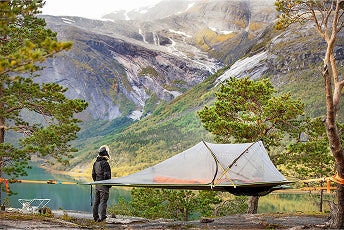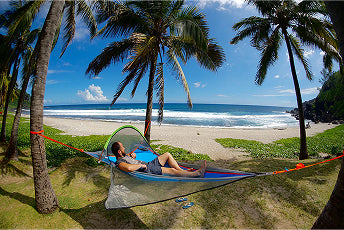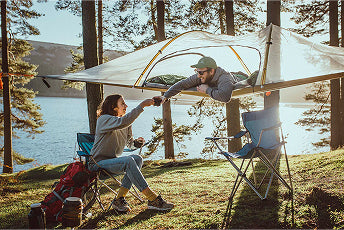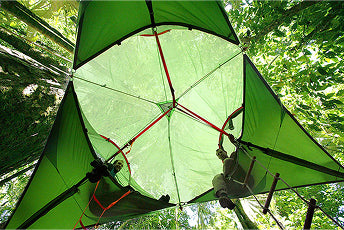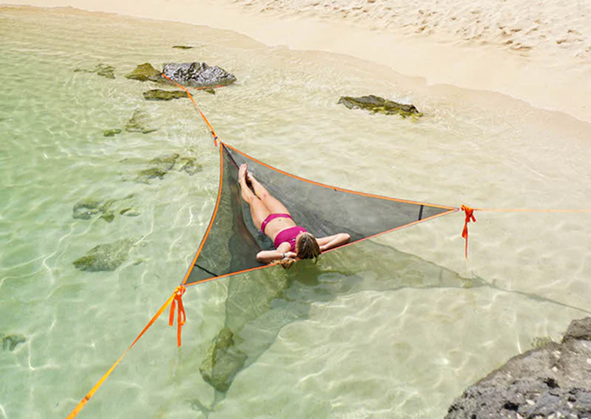Camping hammocks offer a unique camping experience that is unmatched by traditional ground tents. With a suspension system that supports you off the ground, all you really need are some sturdy anchor points for pitching. They are incredibly comfortable and make a great place for relaxing during the day or sleeping at night.
If you’re planning a trip with a camping hammock or hammock tent for the first time, you may be unsure of how to hang your hammock safely and effectively. Or, if you’ve got a few camping trips in the pipeline, you might want to know how to look after your hammock so that it lasts a long time. This guide covers some useful information and shows you where to go for more detailed expert guides from Tentsile.
Click on one of the links below to jump to that section:
Where to Hang Your Camping Hammock
Camping hammocks are lightweight and take up relatively little space in your backpack or stuff sack, meaning they are less cumbersome to carry when hiking, backpacking or staying on a campsite overnight.
When setting out on a camping trip with a hammock, there are a few factors to bear in mind before setting up camp. These include anchor points, weather, location and wildlife. Most Tentsile camping hammocks have a three-point anchor system, so you’ll require three healthy trees or columns to suspend your hammock from. However, some, such as the Solo 1-Person Mesh Hammock, only require two.
Location is one of the most important considerations when choosing where to hang your camping hammock. You don’t want to be too close to water, as this may attract insects and may be at risk of flooding in wetter weather conditions. You should also make sure you are permitted to camp in the spot you’ve chosen, and that you’re not trespassing on private land.
When wild camping and hiking or backpacking, you need to make sure you have a reliable navigation system. This is vital should you lose your bearings, but also helps you identify nearby facilities such as public toilets and bins.
Our guide to hanging your camping hammock covers anchor points, location and more.
How to Hang Your Camping Hammock
Once you’ve decided where to hang your camping hammock, you need to know how to set it up safely and comfortably. The weather will play an important part in this, as you may need some extra accessories such as a tarp, rain fly or bug net to protect you from rain and insects, as well as a sleeping bag and underquilt or sleeping pad to keep you warm.
We recommend having a practice run hanging your hammock before you set off on your trip. It can be tricky knowing how to pitch your hammock at the right angle and with the correct ridgeline, but familiarising yourself with the instructions or having a go in advance should make the process less confusing.
Your first task when hanging your hammock is choosing suitable anchor points. Trees (either two or three depending on your hammock’s anchor system) should be around 15ft apart. You can also use stationary anchors such as posts or cars, or even a simple and quick to assemble portable hammock stand.
If you have a single hammock with a two-point anchor system like the Solo, you should attach the straps 6ft up the tree with knots or a carabiner to allow for the material sag. Our hammocks with a three-point system have taut bases for a flatter surface. Once you’ve attached your hammock to the supports, try it out and make any necessary adjustments then add your extras like an underquilt.
For more information on how to hang your camping hammock safely, including how to tie knots when tying a rope or strap to a support, check out our guide. We’ve also covered how to hang your hammock indoors for all you stay-at-home types.
How to Clean Your Camping Hammock
You should always check your gear before packing away after your camping trip in case anything sharp or sticky has become tangled in or stuck on your hammock. You should never machine wash or dry your hammock, or use household soaps which contain perfumes that can attract insects.
Instead, you should clean your hammock or tree tent with warm water, non-detergent soap and a non-abrasive sponge. Products specially designed to clean load-bearing textiles will also help tackle dirty patches.
After cleaning, your hammock or tree tent should be air-dried in a dry and airy spot, not in direct sunlight. Only once it’s completely dry should you pack it up and store it in a cool, dry place.
Our article How to Clean Your Tentsile discusses cleaning your hammock/tree tent, ratchets, straps and rainflies in more detail.
View our full range of camping hammocks or contact our team today if you would like more expert advice for your next camping trip.

